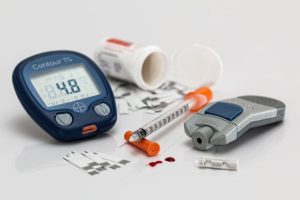3.1 Case Study: Chemistry and Your Life
Created by CK-12/Adapted by Christine Miller
Case Study: Diet Dilemma

Joseph is a college student who has watched his father suffer from complications of type 2 diabetes for the past few years. For people with type 2 diabetes, the hormone insulin does not transmit its signal sufficiently. Insulin normally removes sugar from the bloodstream and brings it into the body’s cells. Diabetes prevents blood sugar levels from being properly regulated, and this can cause damage to the cells.
Diabetes can be treated with insulin injections, as shown above, as well as with dietary modifications, but complications can still occur. Joseph’s father has some nerve damage (or neuropathy) in his feet which makes his feet numb. He didn’t notice when he developed minor injuries to his feet which caused some serious infections.

Joseph is obese and knows that his weight — along with a family history of diabetes — increases his risk of getting the disease himself. He wants to avoid the health issues that his father suffered, so he begins walking every day for exercise and starts to lose weight. Joseph also wants to improve his diet in order to lose more weight, lower his risk of diabetes, and improve his general health, but he is overwhelmed with all of the different dietary advice he reads online and hears from his friends and family.
Joseph’s father tells him to limit refined carbohydrates, such as white bread and rice, because that is what he does to help keep his blood sugar at an acceptable level, but Joseph’s friend tells him that eating a diet high in carbohydrates and low in fat is a good way to lose weight. Joseph reads online that “eating clean” by eating whole, unprocessed foods and avoiding food with “chemicals” can help with weight loss. One piece of advice that everyone seems to agree on is that drinking enough water is good for overall health.
All this dietary advice may sound confusing, but you can better understand health conditions, such as diabetes, and the role of diet and nutrition by understanding chemistry. Chemistry is much more than chemical reactions in test tubes in a lab — it is the atoms, molecules, and reactions that make us who we are and keep us alive and functioning properly. Our diets are one of the main ways our bodies take in raw materials that are needed for the important chemical reactions that take place inside of us.
Chapter Overview: Chemistry
As you read this chapter, you will learn more about how chemistry relates to our lives, health, and the foods we eat. Specifically, you will learn about:
- The nature of chemical substances, including elements, compounds, and their component atoms and molecules.
- The structures and functions of biochemical compounds, including carbohydrates, lipids, proteins, and nucleic acids (such as DNA and RNA).
- What chemical reactions are, how energy is involved in chemical reactions, how enzymes assist in chemical reactions, and some types of biochemical reactions in living organisms.
- Properties of water and the importance of water for most biochemical processes.
- What pH is, and why maintaining a proper pH in the body is important for biochemical reactions.
As you read the chapter, think about the following questions regarding Joseph’s situation, as well as how diabetes and diet relate to the chemistry of life:
- Why do you think Joseph’s father’s diabetes increases Joseph’s risk of getting diabetes?
- What is the difference between refined (simple) carbohydrates and complex carbohydrates? Why are refined carbohydrates particularly problematic for people with diabetes?
- Insulin is a peptide hormone. In which class of biochemical compounds would you categorize insulin?
- Why is drinking enough water important for overall health? Can you drink too much water?
- Sometimes “eating clean” is described as avoiding “chemicals” in food. Think about the definition of “chemicals” and how it relates to what we eat.
Attributions
Figure 3.1.1
Diabetes-equipment by Steve Buissinne [stevepb] on Pixabay is used under the Pixabay License (https://pixabay.com/de/service/license/).
Figure 3.1.2
Early Morning Hike, by Luke Pamer on Unsplash, is used under the Unsplash license (https://unsplash.com/license).
References
Mayo Clinic Staff. (n.d.). Peripheral neuropathy [online article]. MayoClinic.org. https://www.mayoclinic.org/diseases-conditions/peripheral-neuropathy/symptoms-causes/syc-20352061
Mayo Clinic Staff. (n.d.). Type 2 diabetes [online article]. MayoClinic.org. https://www.mayoclinic.org/diseases-conditions/type-2-diabetes/symptoms-causes/syc-20351193

